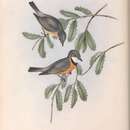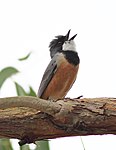en
names in breadcrumbs


'''Pachycephala rufiventris[2] ye una especie d'ave de la familia Pachycephalidae.
Alcuéntrase en Nueva Caledonia, Papúa Nueva Guinea, y por toa Australia (cola esceición de Tasmania). Ye un ave que'l so color predominante ye l'acoloratáu-ablondu y el gris, compensa'l so color pocu vistosu con grandes habilidaes cantores. Al igual qu'otros miembros de la familia Pachycephalidae, tien un conxuntu variáu de llamaes musicales.
Los xibladores ablondu tienen una cabeza prominente y son macizos. Los sos picos son curtios y les sos coles llargues (casi tan llargues como'l restu de l'ave) siendo bien angostes y aguyaes, con estremos abiertos en cuña. La especie presenta dimorfismu sexual. Ente que les femes son d'un tonu pardu pocu vistosu o gris con zona ventral a pintes, los machos son predominantemente d'un color gris escuru con gargüelu blancu y na mayoría de los casos una mascara negra que cubre la mayor parte de la so cabeza y parte del so pescuezu. Miden ente 16 a 18 cm de llargu, y el so pesu ye d'unos 25 gramos.
El xiblador ablondu habita en zones montiegues y de parrotales, anque tamién en xardinos y esplotaciones agrícoles. Mover al sur en primavera y al norte na seronda. En Nueva Caledonia la especie nun migra, y mora en zones de monte abiertu y sabana.
Magar los xibladores ablondos aliméntense principalmente d'inseutos, ellos tamién inxeren granes, frutos y dacuando fueyes y camperes.
Machu xuvenil en Kobble Creek,sudeste de Queensland, Australia
Machu nuevu, sudeste de Queensland, Australia.
Backyards * www.birdphotos.com.au
 Esta páxina forma parte del wikiproyeutu Aves, un esfuerciu collaborativu col fin d'ameyorar y organizar tolos conteníos rellacionaos con esti tema. Visita la páxina d'alderique del proyeutu pa collaborar y facer entrugues o suxerencies.
Esta páxina forma parte del wikiproyeutu Aves, un esfuerciu collaborativu col fin d'ameyorar y organizar tolos conteníos rellacionaos con esti tema. Visita la páxina d'alderique del proyeutu pa collaborar y facer entrugues o suxerencies. '''Pachycephala rufiventris ye una especie d'ave de la familia Pachycephalidae.
Alcuéntrase en Nueva Caledonia, Papúa Nueva Guinea, y por toa Australia (cola esceición de Tasmania). Ye un ave que'l so color predominante ye l'acoloratáu-ablondu y el gris, compensa'l so color pocu vistosu con grandes habilidaes cantores. Al igual qu'otros miembros de la familia Pachycephalidae, tien un conxuntu variáu de llamaes musicales.
Aderyn a rhywogaeth o adar yw Chwibanwr gwinau (sy'n enw gwrywaidd; enw lluosog: chwibanwyr gwinau) a adnabyddir hefyd gyda'i enw gwyddonol Pachycephala rufiventris; yr enw Saesneg arno yw Rufous whistler. Mae'n perthyn i deulu'r Chwibanwyr (Lladin: Pachycephalidae) sydd yn urdd y Passeriformes.[1]
Talfyrir yr enw Lladin yn aml yn P. rufiventris, sef enw'r rhywogaeth.[2] Mae'r rhywogaeth hon i'w chanfod yn Awstralia.
Mae'r chwibanwr gwinau yn perthyn i deulu'r Chwibanwyr (Lladin: Pachycephalidae). Dyma rai o aelodau eraill y teulu:
Rhestr Wicidata:
rhywogaeth enw tacson delwedd Colluricincla ferruginea Pseudorectes ferrugineus Chwibanwr cefnwinau Coracornis raveni Melanorectes nigrescens Melanorectes nigrescens Pitohwi bronfrith Pseudorectes incertusAderyn a rhywogaeth o adar yw Chwibanwr gwinau (sy'n enw gwrywaidd; enw lluosog: chwibanwyr gwinau) a adnabyddir hefyd gyda'i enw gwyddonol Pachycephala rufiventris; yr enw Saesneg arno yw Rufous whistler. Mae'n perthyn i deulu'r Chwibanwyr (Lladin: Pachycephalidae) sydd yn urdd y Passeriformes.
Talfyrir yr enw Lladin yn aml yn P. rufiventris, sef enw'r rhywogaeth. Mae'r rhywogaeth hon i'w chanfod yn Awstralia.
The rufous whistler (Pachycephala rufiventris) is a species of whistler found in New Caledonia and Australia. Predominantly a reddish-brown and grey bird, it makes up for its subdued plumage with its song-making ability. Like many other members of the Pachycephalidae, it has a variety of musical calls.
The rufous whistler was originally described in the genus Sylvia by the English ornithologist John Latham in 1801.[2] It was subsequently classified within the genera Turdus, Laniarius, and Lanius before being classified in its present genus, Pachycephala. Alternate names for the rufous whistler include the rufous-bellied whistler and white-bellied whistler. The latter name should not be confused with the species of the same name, Pachycephala leucogastra. Some authorities have considered the black-headed, drab, and cinnamon-breasted whistlers to be subspecies of the rufous whistler.[3][4][5]
Five subspecies are recognized:[6]
Rufous whistlers are large-headed and stocky. They have short beaks and long tails (almost as long as the rest of the bird) which are very narrow and have sharp, forked tips. The species is sexually dimorphic. While females are typically dull brown or grey with streaked underbodies, males are predominantly dark-grey with white throats and (in most cases) a black mask that covers most of their head and some of their neck. These birds are between 16 and 18 centimetres (6.3 and 7.1 inches) in size, on average, and their normal weight is approximately 25 grams (0.88 ounces).
The rufous whistler has a variety of musical calls which consist of a lengthy series of ringing notes.
The rufous whistler can be found in forested areas, woodland, and shrubland, but also in gardens and farmland. It migrates seasonally, moving south in the spring and north in the autumn. In New Caledonia the species does not undertake migrations but is instead resident in areas of open forest and savannah.
Breeding in monogamous pairs, both males and females incubate their eggs and care for their young. The period of incubation is about 13 days on average. The female alone constructs the nest, which usually consists of a combination of twigs, vines, grass and other matter formed in a cup-like shape and attached to a tree branch using strands from spider webs. The breeding season for rufous whistlers is between the months of July and February.
While rufous whistlers primarily feed on insects, they also eat seeds, fruit and occasionally, leaves and grasses. They never forage for food on the ground which is unusual for whistlers which typically do not forage at particularly high levels.
The rufous whistler (Pachycephala rufiventris) is a species of whistler found in New Caledonia and Australia. Predominantly a reddish-brown and grey bird, it makes up for its subdued plumage with its song-making ability. Like many other members of the Pachycephalidae, it has a variety of musical calls.
El silbador rufo[2] (Pachycephala rufiventris) es una especie de ave paseriforme de la familia Pachycephalidae.[3][4]
Es endémica de Nueva Caledonia y toda Australia (con la excepción de Tasmania).
Es un ave cuyo color predominante es el rojizo-rufo y el gris, compensa su color poco vistoso con grandes habilidades cantoras. Al igual que otros miembros de la familia Pachycephalidae, posee un conjunto variado de llamadas musicales. Los silbadores rufo poseen una cabeza prominente y son macizos. Sus picos son cortos y sus colas largas (casi tan largas como el resto del ave) siendo muy angostas y aguzadas, con extremos abiertos en cuña. La especie presenta dimorfismo sexual. Mientras que las hembras son de un tono pardo poco vistoso o gris con zona ventral a pintas, los machos son predominantemente de un color gris oscuro con garganta blanca y en la mayoría de los casos una máscara negra que cubre la mayor parte de su cabeza y parte de su cuello. Miden entre 16 a 18 cm de largo, y su peso es de unos 25 gramos.
El silbador rufo habita en zonas boscosas y de arbustos, aunque también en jardines y explotaciones agrícolas. Se desplaza al sur en primavera y al norte en otoño. En Nueva Caledonia la especie no migra, y reside en zonas de bosque abierto y sabana.
Si bien los silbadores rufos se alimentan principalmente de insectos, ellos también ingieren semillas, frutos y ocasionalmente hojas y pastos.
Macho joven, sudeste de Queensland, Australia
Se reconocen las siguientes según IOC:[3]
El silbador rufo (Pachycephala rufiventris) es una especie de ave paseriforme de la familia Pachycephalidae.
Pachycephala rufiventris Pachycephala generoko animalia da. Hegaztien barruko Pachycephalidae familian sailkatua dago.
Pachycephala rufiventris Pachycephala generoko animalia da. Hegaztien barruko Pachycephalidae familian sailkatua dago.
Pachycephala rufiventris
Le Siffleur itchong (Pachycephala rufiventris) est une espèce d'oiseaux appartenant à la famille des Pachycephalidae.
Cet oiseau vit en Nouvelle-Calédonie, en Papouasie-Nouvelle-Guinée et en Australie (à l'exception de la Tasmanie).
Principalement rouge-brun et gris, cet oiseau compense son plumage quelconque par la qualité de ses chants. Il a une grosse tête et est trapu. Le bec est court mais la queue est longue (presque aussi longue que le reste de l'oiseau), avec de fortes plumes étroites, fourchues à l'extrémité. L'espèce a un dimorphisme sexuel. Alors que les femelles sont généralement brun mat ou gris avec le ventre strié, les mâles sont principalement gris foncé avec la gorge blanche et (dans la plupart des cas) un masque noir qui couvre la majeure partie de la tête et une partie du cou. Ces oiseaux font entre 16 et 18 centimètres de long, en moyenne, et leur poids moyen est d'environ 25 grammes.
L'ornithologue John Latham en 1802 l'a initialement décrit comme Sylvia rufiventris. Plus tard, il a été considéré comme membre du genre Laniarius avant d'être classé dans le genre Pachycephala.
Il vit dans les zones de forêts et de broussailles, mais aussi dans les jardins et les terres agricoles. Il migre saisonnièrement, se déplaçant vers le sud au printemps et le nord à l'automne. En Nouvelle-Calédonie, l'espèce ne migre pas mais vit plutôt dans les zones de forêt et de savane.
Alors qu'il se nourrit principalement d'insectes, il mange aussi des graines, des fruits et; parfois, des feuilles et de l'herbe. Il ne cherche jamais son alimentation sur le sol, ce qui est inhabituel pour des siffleurs qui, généralement, ne cherchent pas leur nourriture à des niveaux particulièrement élevés.
Les couples sont monogames, les mâles et les femelles couvent les œufs et élèvent leurs jeunes. La période d'incubation est d'environ 13 jours. Les femelles seules construisent le nid, qui consiste généralement en un mélange de brindilles, de tiges souples, d'herbe et d'autres matières qui forment une tasse attachée à une branche d'arbre en utilisant des fils de toile d'araignée. La saison de reproduction va de juillet à février.
Il en existe cinq sous-espèces :
Pachycephala rufiventris
Le Siffleur itchong (Pachycephala rufiventris) est une espèce d'oiseaux appartenant à la famille des Pachycephalidae.
De grijsrugfluiter (Pachycephala rufiventris) is een zangvogel uit de familie Pachycephalidae (dikkoppen en fluiters).
Deze soort telt 5 ondersoorten:
De grijsrugfluiter (Pachycephala rufiventris) is een zangvogel uit de familie Pachycephalidae (dikkoppen en fluiters).
Rostbukig visslare[2] (Pachycephala rufiventris) är en fågel i familjen visslare inom ordningen tättingar.[3] IUCN kategoriserar arten som livskraftig.[1]
Rostbukig visslare delas in i fem underarter med följande utbredning:[3]
Rostbukig visslare (Pachycephala rufiventris) är en fågel i familjen visslare inom ordningen tättingar. IUCN kategoriserar arten som livskraftig.
Rostbukig visslare delas in i fem underarter med följande utbredning:
P. r. minor – Melville och Bathurst (Northern Territory) P. r. falcata – norra Australien (Broome, Western Australia till nordöstra Northern Territory) P. r. pallida – norra och nordvästra Queensland (Nicholsonfloden till Cape York-halvön) P. r. rufiventris – Australien (utom norra och torra trädlösa områden) P. r. xanthetraea – Nya Kaledonien


Pachycephala rufiventris là một loài chim trong họ Pachycephalidae.[1]
Pachycephala rufiventris là một loài chim trong họ Pachycephalidae.
棕啸鹟(学名:Pachycephala rufiventris),是啸鹟科啸鹟属的一种,是全面迁徙的候鸟,分布于新喀里多尼亚和澳大利亚。该物种的保护状况被评为无危。
棕啸鹟的平均体重约为21.0克。栖息地包括亚热带或热带的(低地)干燥疏灌丛、亚热带或热带的湿润低地林、亚热带或热带的旱林、地中海型疏灌丛、种植园、干燥的稀树草原、温带森林、亚热带或热带的红树林和乡村花园。